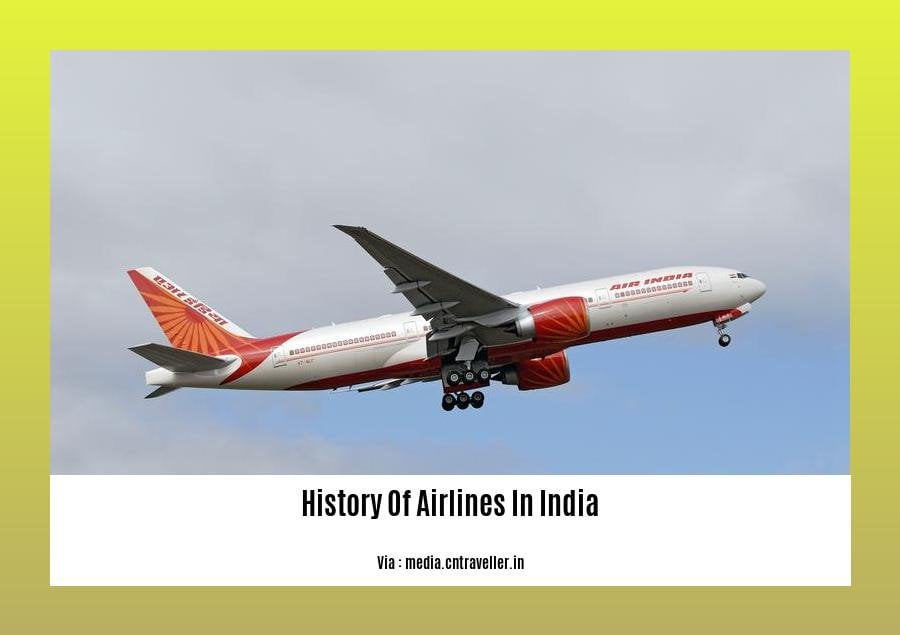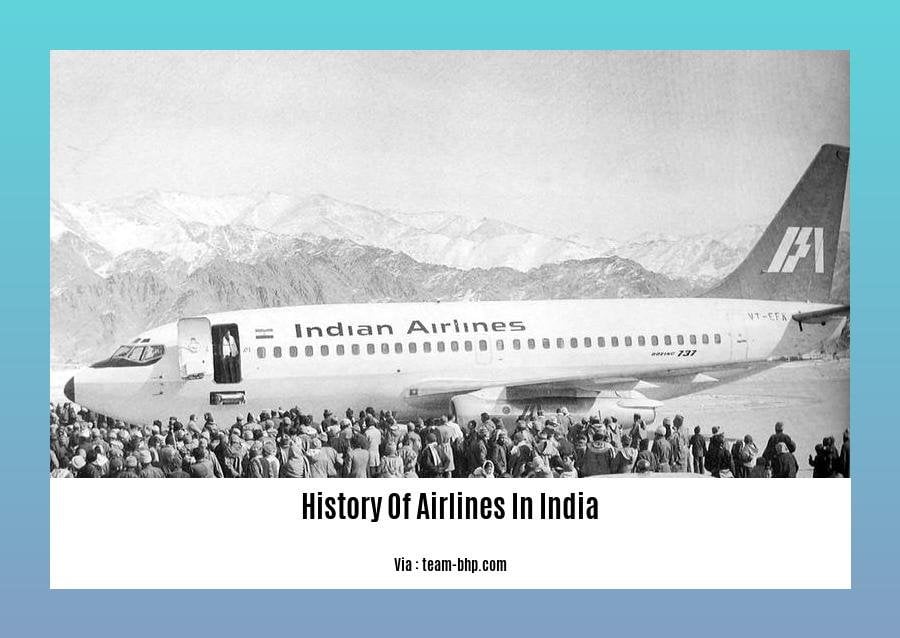Step into the captivating journey of aviation in India, a tale marked by innovation, resilience, and remarkable growth. From humble beginnings to becoming global players, Indian airlines have traversed a path paved with challenges and triumphs. Join us as we trace the rich history of these carriers, exploring their contributions to the nation’s economy, connectivity, and global standing. Prepare to be enthralled by the stories of pioneers, technological advancements, and the unwavering spirit that has shaped the aviation landscape in India—[Tracing the History of Airlines in India: A Journey of Innovation and Growth].
Key Takeaways:
In 1953, Indian Airlines (IC) was established by the Indian government to consolidate the country’s fragmented aviation market.
IC faced competition from private airlines in the early 1990s, leading to a decline in its market share.
IC merged with another state-owned airline, Air India, in 2007, to form a single national carrier.
The merger aimed to create a stronger and more competitive airline capable of competing with private carriers.
The merged entity, named Air India, became the largest airline in India with over 130 aircraft in its fleet.
The merger intended to enhance the efficiency and profitability of both airlines while establishing a robust national carrier.
India’s aviation history dates back to 1911 with the inception of the first airmail service in Allahabad.
India ascended to become the world’s third-largest domestic aviation market, surpassing the United Kingdom.
The aviation industry’s growth in India has been driven by various factors, including rising disposable incomes, increased tourism, and the expansion of budget airlines.
The Indian government, through policies and regulations, has played a pivotal role in the development of the aviation industry.
**History of Airlines in India**

Embark on a journey through the annals of Indian aviation, where innovation and growth have propelled the nation to new heights. From humble beginnings to global recognition, the chronicles of Indian airlines are a testament to the indomitable spirit of the industry.
Laying the Foundation: The Early Years
In the early 1900s, India was not yet touched by the magic of aviation. But in 1911, a defining moment occurred when India’s first airmail service took flight in Allahabad, forging a new era of connectivity. The skies over the nation were abuzz with excitement as the pioneering aviators showcased their prowess and the potential of air travel.
Growth and Expansion: The Post-Independence Era
With India’s independence in 1947, the aviation industry saw a surge in growth. The government recognized the strategic significance of air travel and established Indian Airlines (IC) in 1953 to consolidate the fragmented local market.
IC quickly expanded its reach, connecting cities across the vast Indian landscape. The airline’s iconic red and white livery became synonymous with reliable air travel, earning the trust of passengers and playing a crucial role in the nation’s economic development.
Facing Challenges: The Rise of Private Airlines
The 1990s brought a new era of competition with the emergence of private airlines. These new entrants, with their sleek fleets and competitive pricing, challenged IC’s dominance in the market. IC faced intense pressure to adapt and innovate to retain its position as the leading airline in India.
A New Dawn: The Merger of IC and Air India
In 2007, a pivotal moment in Indian aviation occurred when IC merged with Air India, another state-owned airline. This strategic move aimed to create a single, formidable national carrier that could compete effectively with the private players.
The merged entity, christened Air India, emerged as the largest airline in India, boasting a fleet of over 130 aircraft. This merger marked a new chapter in the history of Indian aviation, demonstrating the government’s commitment to strengthening the industry.
Soaring High: The Current Landscape
Today, the **history of airlines in India** is one of continuous growth and evolution. India has become the world’s third-largest domestic aviation market, surpassing the United Kingdom. This remarkable achievement is attributed to several factors:
- Rising disposable incomes leading to increased demand for air travel.
- Rapid growth in tourism, attracting both domestic and international travelers.
- The expansion of low-cost airlines, making air travel more accessible to a broader segment of the population.
- Supportive government policies and regulations that have fostered the growth of the industry.
The future of Indian aviation looks even brighter, with projections of continued growth in passenger traffic and the emergence of new players in the market. The sky’s the limit for the Indian aviation industry as it continues to soar to new heights, connecting people, businesses, and cultures.
Curious about how African clothing came to be? Read the rich history of African clothing from early civilizations to modern times, exploring the vibrant colors, unique designs, and cultural significance of African fashion.
Discover the fascinating journey of African fashion from its ancient origins to modern-day trends. Explore the rich history of African fashion and witness the evolution of traditional attire, textiles, and cultural influences that have shaped the vibrant tapestry of African style.
Delve into the compelling narrative of the Agusan del Sur region. Uncover the captivating history of Agusan del Sur, from its indigenous roots to its colonial past, and gain a deeper appreciation for its rich cultural heritage and resilience in the face of adversity.
Liberalization and the emergence of private airlines
Remember 1986? That was when India took a bold step towards liberalization, allowing the private sector to soar into the skies. This move birthed a wave of new airlines, igniting competition and offering consumers more choices than ever before. Let’s take a quick trip back in time to witness this transformational era.
In 1994, Jet Airways and Air Sahara took flight, becoming the pioneers of India’s private airline industry. These trailblazers paved the way for a more dynamic and competitive aviation landscape. Fast forward to 2003, and the arrival of Air Deccan, India’s first low-cost carrier (LCC), changed the game completely. Air Deccan democratized air travel, making it accessible to the masses.
The ripple effects of liberalization were far-reaching. Competition intensified, driving down fares and expanding route networks. Passengers rejoiced as they were no longer held captive by a single dominant carrier. Choice became the name of the game, with airlines vying for customers’ attention through innovative services and competitive pricing.
The Indian government recognized the positive impact of liberalization and took further steps to encourage foreign investment in the aviation sector. In 2004, they raised the foreign ownership limit for Indian carriers from 40% to 49%, inviting global players to join the Indian aviation story.
Key Takeaways:
- Liberalization: India’s aviation industry underwent a paradigm shift in 1986 when the government embraced liberalization, paving the way for private sector participation.
- Pioneers: Jet Airways and Air Sahara emerged as the frontrunners, launching operations in 1994 and ushering in a new era of competition.
- Low-cost Revolution: Air Deccan’s entry in 2003 marked the dawn of low-cost carriers in India, making air travel accessible to a broader segment of the population.
- Increased Competition: Liberalization sparked intense competition among airlines, leading to reduced fares, expanded routes, and improved services.
- Foreign Investment: The Indian government’s decision to raise the foreign ownership limit attracted global players, fostering investment and expertise in the aviation sector.
Citations:
- The Impact of International Air Service Liberalization on India
- ScienceDirect
Challenges faced by the Indian aviation industry

Turbulence ahead: The Indian aviation industry is soaring high, but it’s not without its trials. Let’s take a closer look at the challenges that keep airline executives awake at night.
1. The pandemic’s lingering impact
The COVID-19 pandemic dealt a severe blow to the aviation industry worldwide, and India was no exception. With travel restrictions, lockdowns, and plummeting passenger demand, airlines faced unprecedented revenue losses. While the skies are reopening and travel is picking up, the industry is still recovering from the aftershocks of the pandemic.
2. ATF woes: A costly affair
Aviation turbine fuel (ATF), a major operating expense for airlines, has seen a steep rise in prices in recent years. India, heavily reliant on imported oil, is particularly vulnerable to global oil price fluctuations. High ATF costs squeeze airline margins and make it challenging to keep fares affordable for passengers.
3. Infrastructure constraints: Room to grow
India’s aviation infrastructure, despite significant improvements, still lags behind the country’s rapidly growing air travel demand. Congestion at major airports, limited regional connectivity, and inadequate ground handling facilities pose operational challenges and hamper the smooth flow of air traffic.
4. Competition and market dynamics
The Indian aviation market is fiercely competitive, with several major players vying for market share. This competition, while driving innovation and efficiency, also leads to price wars and wafer-thin margins, making it difficult for airlines to sustain profitability.
5. Geopolitical headwinds: Clear skies or turbulence ahead?
Geopolitical tensions and conflicts can significantly impact the aviation industry. Airspace closures, travel restrictions, and security concerns can disrupt flight schedules, increase costs, and lead to route diversions, adding to the operational challenges faced by airlines.
Key Takeaways:
- The Indian aviation industry is grappling with the lingering effects of the pandemic, leading to depressed air travel demand.
- High aviation turbine fuel (ATF) prices, driven by global oil dynamics, strain airline profitability.
- Infrastructure constraints, including airport congestion and limited regional connectivity, hinder the efficient operation of airlines.
- Intense competition and market dynamics make it challenging for airlines to achieve sustainable profitability.
- Geopolitical headwinds, such as airspace closures and travel restrictions, add to the operational complexities of airlines.
Sources:
Challenges and risks of the aviation industry in 2022
Indian aviation – once a promising industry with aspirational jobs – has been floundering in recent years.
Current status and future prospects
Unlocking new skies, India’s aviation industry has recorded a dazzling takeoff, soaring to exciting heights. With technology as its beacon and improved connectivity as its guide, this industry has left a trail of innovation in its wake.
Key Takeaways:
- India is now the third-largest aviation market globally, and it’s expected to keep climbing.
- The government is launching initiatives to make regional air travel more affordable and accessible.
- The industry faces challenges like high operational costs and fierce competition.
- New technologies and sustainable practices are shaping the future of Indian aviation.
Current status:
With rising disposable incomes and a burgeoning middle class, India’s aviation sector has enjoyed a remarkable flight path. The country’s airports have witnessed a surge in passenger traffic, with new airlines taking wing and existing ones expanding their horizons.
The industry’s growth has been catalyzed by the government’s focus on improving infrastructure, such as airports and air traffic control systems. Furthermore, initiatives like the Regional Connectivity Scheme (RCS) and UDAN (Ude Desh ka Aam Nagrik) have been instrumental in promoting regional connectivity and making air travel more accessible to smaller cities.
Future prospects:
The future of Indian aviation appears to be soaring high, with predictions of sustained growth. The industry is expected to witness a surge in passenger traffic, driven by various factors, including:
- India’s rapidly growing population
- Increasing urbanization
- Rising disposable incomes
- Growing tourism
- Government initiatives to promote regional connectivity
To harness this potential, the industry is embracing new technologies and sustainable practices. The adoption of artificial intelligence (AI), machine learning (ML), and data analytics is enhancing operational efficiency, improving customer experiences, and optimizing air traffic management.
Furthermore, airlines are actively pursuing sustainability initiatives to reduce their environmental impact. This includes adopting fuel-efficient aircraft, implementing eco-friendly practices, and exploring the use of sustainable aviation fuels.
Challenges:
Despite the industry’s remarkable growth, it faces several challenges that could potentially hinder its progress. These challenges include:
- High operational costs, including fuel prices and airport charges
- Intense competition, both from domestic and international airlines
- Infrastructure constraints, such as airport congestion and limited runway capacity
- Stringent regulations and complex approval processes
Government initiatives:
The Indian government is actively addressing these challenges through various initiatives. These include:
- Investing in infrastructure development, such as new airports and air traffic control systems
- Promoting regional connectivity through schemes like RCS and UDAN
- Simplifying regulatory processes and reducing bureaucratic hurdles
- Providing incentives to airlines to adopt sustainable practices
Conclusion:
With a robust current status and promising future prospects, India’s aviation industry is poised for continued success. The government’s focus on infrastructure development, regional connectivity, and sustainability will play a crucial role in shaping the industry’s trajectory. As the industry navigates challenges and embraces innovation, it is well-positioned to soar even higher, contributing significantly to India’s economic growth and global connectivity.
Sources:
- Indian Aviation Industry: Current Scenario and Future Prospects
- India’s Aviation Sector: Current Status and Future Prospects
FAQ
Q1: How did the Indian aviation industry evolve from its humble beginnings?
A1: The Indian aviation sector, with roots in the early 1900s, initially focused on airmail services. After World War II, the industry was nationalized, but liberalization efforts in the 1980s allowed private airlines to enter the market, shaping the modern competitive landscape of affordable air travel options.
Q2: What factors contributed to India’s position as the world’s third-largest domestic aviation market?
A2: India’s growing middle class, increased connectivity, and the rise of low-cost carriers have fueled the expansion of the Indian aviation market. These factors, coupled with government initiatives like the Regional Connectivity Scheme, have made air travel more accessible and played a role in pushing India’s ranking to the third spot globally.
Q3: What challenges does the Indian aviation industry face in maintaining sustainable growth?
A3: The industry faces several challenges, including high operating costs due to fuel expenses and infrastructure limitations. Intense competition, particularly from low-cost carriers, also puts pressure on profitability. These factors require strategic management and innovative approaches to ensure sustained growth.
Q4: How did the merger between Indian Airlines and Air India in 2007 impact the aviation landscape in India?
A4: The merger between Indian Airlines and Air India aimed to create a stronger, more competitive national carrier. The combined entity, Air India, emerged as the largest airline in India with a substantial fleet. The merger aimed to improve efficiency, profitability, and global competitiveness for India’s aviation sector.
Q5: What government initiatives support the growth and development of the Indian aviation industry?
A5: Government initiatives such as the Regional Connectivity Scheme (RCS) and the UDAN scheme have played a significant role in promoting regional connectivity and making air travel more affordable. These schemes provide subsidies and incentives to airlines that operate flights to underserved and remote regions, thereby enhancing the accessibility and reach of air travel across India.











